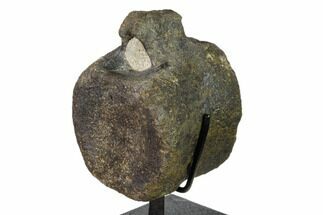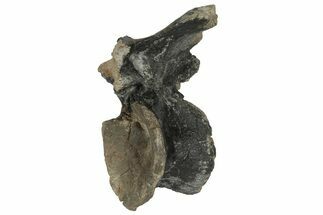This Specimen has been sold.
6" Hadrosaur (Edmontosaurus) Anterior Caudal Vertebrae - Montana
This is a pair of associated caudal vertebrae of a hadrosaur (Edmontosaurus annectens) from the Hell Creek Formation of Montana. They've been left as they were found in the ground, with a small section of matrix present between the two vertebrae. They are the proximal-most (anterior) caudal vertebrae and would have articulated with the sacrum. The processes were eroded away, that top of the vertebrae was cut flat allowing it to sit nicely on a hard surface.
The vertebrae measure 5.4" tall and 2.5" thick each, and sit upright nicely on a flat surface. Comes with an acrylic display stand to assist with presentation.
The anterior-most vertebra has repaired cracks along the right side of the centrum. The base of each transverse process is still present. Just superior to the pedicles, the bone has been cut flat.
The vertebrae measure 5.4" tall and 2.5" thick each, and sit upright nicely on a flat surface. Comes with an acrylic display stand to assist with presentation.
The anterior-most vertebra has repaired cracks along the right side of the centrum. The base of each transverse process is still present. Just superior to the pedicles, the bone has been cut flat.
About Edmontosaurus
Edmontosaurus is one of the largest Hadrosaurs, and one of the most widespread: fossil remains have been found across western North America, from Colorado to northern Alaska. This large herbivore was about the same size as the contemporary predator Tyrannosaurus, reaching 39 feet in length and an average weight of about 6 tons. Named after Edmonton, the capital of the Canadian province of Alberta where its first fossils were discovered, Edmontosaurus was a gregarious terrestrial herbivore that ground up low-lying plant material with its large battery of ever-restoring teeth. Numerous skin impressions and mummified specimens show us that Edmontosaurus had scaly skin, and its forelimbs were enclosed in a fleshy "mitten" serving a purpose similar to a hoof. Edmontosaurus was a member of the Saurolophine clade of Hadrosaurs, meaning they had little to nonexistent crests on the backs of their skulls.
Edmontosaurus is one of the largest Hadrosaurs, and one of the most widespread: fossil remains have been found across western North America, from Colorado to northern Alaska. This large herbivore was about the same size as the contemporary predator Tyrannosaurus, reaching 39 feet in length and an average weight of about 6 tons. Named after Edmonton, the capital of the Canadian province of Alberta where its first fossils were discovered, Edmontosaurus was a gregarious terrestrial herbivore that ground up low-lying plant material with its large battery of ever-restoring teeth. Numerous skin impressions and mummified specimens show us that Edmontosaurus had scaly skin, and its forelimbs were enclosed in a fleshy "mitten" serving a purpose similar to a hoof. Edmontosaurus was a member of the Saurolophine clade of Hadrosaurs, meaning they had little to nonexistent crests on the backs of their skulls.
Because of its age and sedimentary composition, the Hell Creek Formation has become one of the most paleontologically studied areas in the world. 158 genera of animals and 64 genera of plants are known from the formation and new discoveries are made frequently. In addition to Tyrannosaurs, Ceratopsids, and Hadrosaurs, the formation has yielded remains of amphibians, reptiles, lizards, snakes and turtles, fish and sharks, avian and non-avian dinosaurs, and mammals. The Hell Creek Formation gives the most complete understanding of the environment just before the Cretaceous-Paleogene extinction.
SPECIES
Edmontosaurus annectens
LOCATION
Fallon County, Eastern Montana
FORMATION
Hell Creek Formation
SIZE
Entire specimen: 6 x 5.4 x 5.4"
CATEGORY
SUB CATEGORY
ITEM
#248800
We guarantee the authenticity of all of our specimens.
 Reviews
Reviews
















